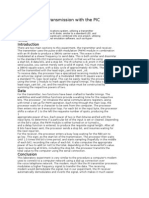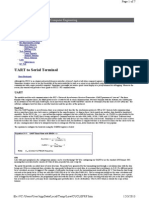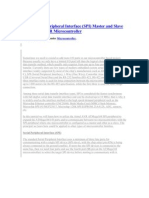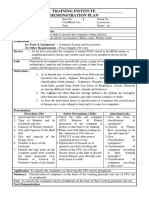Infrared Data Transmission With The PIC Microcontroller: Matthew Beckler Beck0778@umn - Edu EE2361 Lab 007 May 5, 2006
Infrared Data Transmission With The PIC Microcontroller: Matthew Beckler Beck0778@umn - Edu EE2361 Lab 007 May 5, 2006
Uploaded by
anujchopra007Copyright:
Available Formats
Infrared Data Transmission With The PIC Microcontroller: Matthew Beckler Beck0778@umn - Edu EE2361 Lab 007 May 5, 2006
Infrared Data Transmission With The PIC Microcontroller: Matthew Beckler Beck0778@umn - Edu EE2361 Lab 007 May 5, 2006
Uploaded by
anujchopra007Original Title
Copyright
Available Formats
Share this document
Did you find this document useful?
Is this content inappropriate?
Copyright:
Available Formats
Infrared Data Transmission With The PIC Microcontroller: Matthew Beckler Beck0778@umn - Edu EE2361 Lab 007 May 5, 2006
Infrared Data Transmission With The PIC Microcontroller: Matthew Beckler Beck0778@umn - Edu EE2361 Lab 007 May 5, 2006
Uploaded by
anujchopra007Copyright:
Available Formats
Infrared Data Transmission with the PIC Microcontroller
Matthew Beckler beck0778@umn.edu EE2361 Lab 007 May 5, 2006
Abstract To create an infrared communications system, utilizing a transmitter and receiver, you will need one IR diode, similar to a standard LED, and one IR receiver. Two project boards are combined into one project, utilizing two computers running terminal emulation software, such as HyperTerminal.
Introduction
There are two main sections to this experiment, the transmitter and receiver. The transmitter uses the pulse width modulation (PWM) module in combination with an IR diode to produce a 38KHz carrier wave. This wave is then modulated at a slower frequency to send data. This is both similar and dissimilar to the standard RS-232 transmission protocol, in that we will be using a start bit, 8 data bits, and a stop bit. The IR scheme is dierent in that to send a pulse, you cannot merely sent a solid IR signal. You must instead send a 38KHz square wave, with a duty cycle of approximately 40-50%. The signal will be transmitted with the least-signicant bits sent rst. To receive data, the processor has a specialized receiving module that converts an active-low signal consisting of a modulated 38KHz IR square wave into a standard TTL logic level signal. This can be easily read by the processor, using the timer 2 module to mark apart the signal timings. The data is received least-signicant bit rst, and the resulting value must be constructed by summing the respective powers of two.
Data
For the transmitter, two functions have been crafted to handle timings. The wait600us and wait1000us functions provide a waiting time for the respective bits. The processor rst initializes the serial communications registers, along with timer 2 set-up for PWM operation. Each time through the main loop, the processor waits for a character to be sent from the computer. The processor then enters into an 8-execution loop. For each bit in the input byte, the processor shifts a value of 1 to the left the requesite number of spots, producing the 1
appropriate power of two. Each power of two is then bitwise-anded with the input byte, to determine if a particular bit of the input is set or cleared. Depending on the bits value, the PWM module is either turned-on or turned-o, and a delay function is entered, to produce the requisite signal length. After all 8 bits have been sent, the processor sends a stop bit, and resumes waiting for the next input bit. For the receiver, the processor enters a busy loop waiting for the RB0 pin to go low. This signies the start bit of the transmission. The processor then waits until 1.5 times the bits time period, and starts sampling (hopefully in the middle of each bit), recording the value of each bit. It also computes the appropriate power of two to add (or not) to the total, depending on the received bits value. Upon receiving all 8 bits, including the stop bit, the processor transmits the total value to the computer using the serial connection.
Conclusion
This laboratory experiment is very similar to the procedure a computers modem uses to connect to a computer network using a dial-up connection over the voice telephone network. The modem, much like the IR transmitter processor, modulates a higher frequency signal to transfer the data. The receiving modem would demodulate the signal, but in our experiment, the IR receiver automatically demodulates and inverts the signal, which makes it much easier to decode.
C Language Program - Transmitter
#include <p18f452.h> #pragma config OSC=HSPLL, WDT=OFF, BOR=OFF, PWRT=ON void putch(char byte) { while (!PIR1bits.TXIF); TXREG = byte; } char getch(void) { while (!PIR1bits.RCIF); return RCREG; } void wait600us(void) { int x = 453; while(x--); } void wait800us(void) { int x = 610; while(x--); } void wait1000us(void) { int x = 762; while(x--); } void main(void) { //initialize variables char input, whichBit, temp; //initialize serial registers TXSTAbits.TXEN = 1; RCSTAbits.SPEN = 1; RCSTAbits.CREN = 1; SPBRG = 0x40; TRISC = 0; //initialize timer2 for PWM use T2CON = 0b00000101; 3
PR2 = 65; //initialize PWM module CCPR1L = 32; //CCP1CON = 0b00001100; //start off putch(T); putch(X); putch(0x0d); putch(0x0a); while(1) { putch(-); putch(>); putch( ); //wait for input from the computer input = getch(); //input = 0x41; // A putch(input); putch(0x0d); putch(0x0a); CCP1CON = 0x0C; wait800us(); whichBit = 0; while(whichBit < 8) { temp = 1 << whichBit; if ((input & temp) == 0) { CCP1CON = 0x0C; wait800us(); } else { CCP1CON = 0x00; wait800us(); } whichBit++; } CCP1CON = 0x00; wait800us(); } }
C Language Program - Receiver
#include <p18f452.h> #pragma config OSC=HSPLL, WDT=OFF, BOR=OFF, PWRT=ON void putch(char byte) { while (!PIR1bits.TXIF); TXREG = byte; } char getch(void) { while (!PIR1bits.RCIF); return RCREG; } void wait800us(void) { int x = 610; while(x--); } void main(void) { //initialize variables char input, whichBit, temp, total; //initialize serial registers TXSTAbits.TXEN = 1; RCSTAbits.SPEN = 1; RCSTAbits.CREN = 1; SPBRG = 0x40; //Setup PORTB INTCON2bits.RBPU = 0; TRISB = 0x0F; PORTB = 0; //Setup Timer2 T2CON = 0x79; //PRE = 4 POST = 16 PR2 = 187; putch(R); putch(x); putch(0x0D); putch(0x0A); while(1) { while(!PORTBbits.RB0); T2CONbits.TMR2ON = 1; 5
whichBit = 0; total = 0; while(whichBit < 8) { while(!PIR1bits.TMR2IF); PR2 = 125; PIR1bits.TMR2IF = 0;
if(PORTBbits.RB0 == 0) { temp = 1 << whichBit; total += temp; } whichBit++; } putch(total); T2CONbits.TMR2ON = 0; PR2 = 187; } }
Figure 1: Transmitter Circuit Schematic 7
Figure 2: Receiver Circuit Schematic 8
You might also like
- Infrared Data Transmission With The PIC MicrocontrollerDocument9 pagesInfrared Data Transmission With The PIC MicrocontrollerVenkatesan RamamoorthyNo ratings yet
- Abstract 2. Circuit Diagram 3. Explanation 4. Working 5. Program Code 6. PCB Layout Fabrication and Assembly 8. Conclusion 9. Reference 10. DatasheetDocument22 pagesAbstract 2. Circuit Diagram 3. Explanation 4. Working 5. Program Code 6. PCB Layout Fabrication and Assembly 8. Conclusion 9. Reference 10. Datasheetaditya_pundirNo ratings yet
- Project 2Document19 pagesProject 2Gaurav BaluNo ratings yet
- Lab 5Document15 pagesLab 5nguyen minh giangNo ratings yet
- UARTDocument27 pagesUARTNaveen Kumar100% (1)
- Session 5Document31 pagesSession 5Aravinth RameshNo ratings yet
- UART - Universal Asynchronous Receiver TransmitterDocument26 pagesUART - Universal Asynchronous Receiver TransmitterSivaprasad Reddy100% (3)
- Serial Communication With 8051Document25 pagesSerial Communication With 8051prakriti sankhlaNo ratings yet
- Tech-Tutorials Pic32-Tutorials Pic32mDocument7 pagesTech-Tutorials Pic32-Tutorials Pic32mAlgoNo ratings yet
- Design and Simulation of Uart Protocol Based On Verilog: B.Jeevan & M.NeerajaDocument4 pagesDesign and Simulation of Uart Protocol Based On Verilog: B.Jeevan & M.NeerajaTushar JainNo ratings yet
- Baud Rate Generator:: Homework Assignment # 4Document5 pagesBaud Rate Generator:: Homework Assignment # 4Badrinath Balasubramanian100% (1)
- UART in LPC2148 ARM7 MicrocontrollerDocument8 pagesUART in LPC2148 ARM7 Microcontrollerrudra_1No ratings yet
- Design of A Micro-Uart For Soc ApplicationDocument12 pagesDesign of A Micro-Uart For Soc ApplicationUtkarsh Jain100% (1)
- Unit 5Document83 pagesUnit 5Vyshnavi Challa ObullaNo ratings yet
- Serial Communication Rv01Document29 pagesSerial Communication Rv01sivaperumalNo ratings yet
- ECR MachineDocument37 pagesECR Machineapi-3721578100% (1)
- Embedded C Module 4Document29 pagesEmbedded C Module 4Sampath ShettyNo ratings yet
- 2.design and Simulation of UART Serial Communication Module Based On VHDLDocument4 pages2.design and Simulation of UART Serial Communication Module Based On VHDLsattarsekharNo ratings yet
- Using UART of PIC Microcontroller With Hi-Tech CDocument13 pagesUsing UART of PIC Microcontroller With Hi-Tech CYoussef KhairaneNo ratings yet
- Development Board For Stm8S003F3: by Nitin Chand M S (2018H1400171P), Rohith Krishnan P (2018H1400180P)Document13 pagesDevelopment Board For Stm8S003F3: by Nitin Chand M S (2018H1400171P), Rohith Krishnan P (2018H1400180P)Thông NguyễnNo ratings yet
- 8051 CH10 950217Document110 pages8051 CH10 950217shivaspyNo ratings yet
- Rohit Edsp Lab 8bDocument12 pagesRohit Edsp Lab 8brohit SinghNo ratings yet
- Z3 2 4Document104 pagesZ3 2 4Vu Duc Hoan100% (1)
- Komunikacija Između Mikrokontrolera. Uart, Spi, I2C AD I DA KonverzijaDocument18 pagesKomunikacija Između Mikrokontrolera. Uart, Spi, I2C AD I DA KonverzijaHury999No ratings yet
- B. Tech ProjectDocument52 pagesB. Tech ProjectSanthosh KammamNo ratings yet
- Circuit Diagram Wireless TransmitterDocument17 pagesCircuit Diagram Wireless Transmitterumaiya1990100% (2)
- Using Serial Peripheral InterfaceDocument21 pagesUsing Serial Peripheral InterfaceArton TonoNo ratings yet
- PIC18F4550 USART - PIC ControllersDocument8 pagesPIC18F4550 USART - PIC ControllersKrishanu Modak100% (1)
- DHTDocument9 pagesDHTNoman Jabbar100% (2)
- CH 6Document24 pagesCH 6Muhammad MustafaNo ratings yet
- Design of A PPM Modulator With VHDLDocument10 pagesDesign of A PPM Modulator With VHDLMarcos Guerra MedinaNo ratings yet
- Design and Implementation of UART Based On VerilogDocument7 pagesDesign and Implementation of UART Based On VeriloglabibatariqueNo ratings yet
- AcumulatorDocument12 pagesAcumulatortaketastNo ratings yet
- Lab3 - Laboratory For Experimental Computer ScienceDocument9 pagesLab3 - Laboratory For Experimental Computer ScienceGauthier G. LetellierNo ratings yet
- 8051 CH10Document93 pages8051 CH10Murali KrishnaNo ratings yet
- Universal Asynchronous Receiver Transmitter-IT CAN WORKING AS A DUPLEX AND Full Duplex. in Uart Some Parameters Are Set by Users AreDocument6 pagesUniversal Asynchronous Receiver Transmitter-IT CAN WORKING AS A DUPLEX AND Full Duplex. in Uart Some Parameters Are Set by Users AreteekamNo ratings yet
- UG - EC303 DSP Part-6 On-Chip Peripherals-Print PDFDocument20 pagesUG - EC303 DSP Part-6 On-Chip Peripherals-Print PDFapuurvaNo ratings yet
- Unit 3 - Real World Interfacing With ARM7 Based Microcontroller - NotesDocument21 pagesUnit 3 - Real World Interfacing With ARM7 Based Microcontroller - Noteskbtug22384No ratings yet
- Embedded System Kerala University Module 1 NotesDocument13 pagesEmbedded System Kerala University Module 1 NotesAssini Hussain100% (1)
- 17CS563 Mod2Document24 pages17CS563 Mod2qwerty qwertyNo ratings yet
- Humidity and Temperature: About DHT11 SensorDocument4 pagesHumidity and Temperature: About DHT11 SensorminiecateNo ratings yet
- University Automoma of Queretaro Engineering Faculty: Digital System 2Document15 pagesUniversity Automoma of Queretaro Engineering Faculty: Digital System 2Carlos Eduardo Martínez Hernández100% (1)
- 3.working Principal. 4.circuit Diagram. 5.conclusionDocument9 pages3.working Principal. 4.circuit Diagram. 5.conclusionSumit JoshiNo ratings yet
- E XMCR6A 071 SATP8 Features (28) R01 150928aDocument28 pagesE XMCR6A 071 SATP8 Features (28) R01 150928aKelvin LeongNo ratings yet
- Lab 4Document34 pagesLab 4manjunathNo ratings yet
- 8051 UartDocument9 pages8051 Uartgajanan kaknaleNo ratings yet
- Unit 3 UARTDocument15 pagesUnit 3 UARTVanshika KhandelwalNo ratings yet
- Sony Sirc ProtocolDocument10 pagesSony Sirc ProtocolFrancisco HernandezNo ratings yet
- Design of FFT SpectrumDocument7 pagesDesign of FFT SpectrumGiovanny PovedaNo ratings yet
- Speed Detector For HighwaysDocument29 pagesSpeed Detector For HighwaysShama MahinNo ratings yet
- HBridgeMotorControl With PICDocument11 pagesHBridgeMotorControl With PICcoceicr100% (3)
- RPM IndicatorDocument39 pagesRPM IndicatorAnkur PatelNo ratings yet
- Serial Communication 2Document31 pagesSerial Communication 2jaigodara100% (1)
- Industrial Fault Indication System With Over Voltage Over TemperatureDocument46 pagesIndustrial Fault Indication System With Over Voltage Over Temperaturedivanshu16decNo ratings yet
- National Institute of Technology, Rourkela: Embedded Systems LaboratoryDocument13 pagesNational Institute of Technology, Rourkela: Embedded Systems Laboratoryprateekkumardash2002No ratings yet
- PCF8582C-2: 1. DescriptionDocument21 pagesPCF8582C-2: 1. DescriptionroozbehxoxNo ratings yet
- TA0045 4 Channel Relay ModuleDocument3 pagesTA0045 4 Channel Relay ModuleIce brandNo ratings yet
- 42 POWER8 Enterprise E870 From ExperienceDocument63 pages42 POWER8 Enterprise E870 From ExperienceAntonio A. Bonita100% (1)
- Qn:Explain Different Latency Hiding Techniques /mechanisms? (Ans:Describe Sections 6.1.2,6.1.3, 6.1.5, 6.2.2.)Document28 pagesQn:Explain Different Latency Hiding Techniques /mechanisms? (Ans:Describe Sections 6.1.2,6.1.3, 6.1.5, 6.2.2.)ripcord jakeNo ratings yet
- ARM Processor RoadmapDocument23 pagesARM Processor RoadmapKi Ki100% (1)
- Intel 64 and IA-32 Architectures: Software Developer's ManualDocument422 pagesIntel 64 and IA-32 Architectures: Software Developer's Manualsir_ajronNo ratings yet
- Computer OrganizationDocument8 pagesComputer OrganizationVeerabhadra Durgam100% (1)
- PRA1Document15 pagesPRA1najlaecasalsgraciaNo ratings yet
- Starte CDocument1 pageStarte CFernandez FelixNo ratings yet
- Arm Cortex-A9 Mpcore Processor: Presented byDocument25 pagesArm Cortex-A9 Mpcore Processor: Presented byJawwad RafiqNo ratings yet
- AN 3110 Computer Tech PowerPoint LectureDocument61 pagesAN 3110 Computer Tech PowerPoint LectureKshitij PalNo ratings yet
- 01 - CX600-X Series Products Hardware Introduction ISSUE 1 - 01Document0 pages01 - CX600-X Series Products Hardware Introduction ISSUE 1 - 01Анатолий Петьков100% (1)
- Intel CoreDocument12 pagesIntel CoreKrushna G DhananiNo ratings yet
- Patterson6e MIPS Ch01 PPTDocument49 pagesPatterson6e MIPS Ch01 PPTalapabainviNo ratings yet
- P R Gangoda: Industrial Training Institute - Demonstration PlanDocument1 pageP R Gangoda: Industrial Training Institute - Demonstration Planrakesh19865No ratings yet
- 4.3 Sibelius Sounds EssentialsDocument14 pages4.3 Sibelius Sounds Essentialsrita_319No ratings yet
- CS 258 Parallel Computer Architecture: CS 258, Spring 99 David E. Culler Computer Science Division U.C. BerkeleyDocument44 pagesCS 258 Parallel Computer Architecture: CS 258, Spring 99 David E. Culler Computer Science Division U.C. BerkeleyMurali SrinivasaiahNo ratings yet
- LMI НС3926 PDFDocument45 pagesLMI НС3926 PDFГригорий Григорян100% (4)
- Csi 3131 Midterm W13 SolnDocument10 pagesCsi 3131 Midterm W13 SolnAndrey SafonovNo ratings yet
- General Music Equinox Service ManualDocument20 pagesGeneral Music Equinox Service Manualcoldiz70No ratings yet
- My Lecture1 Introductiona PDFDocument28 pagesMy Lecture1 Introductiona PDFchaitu4No ratings yet
- Computer Organization and Architecture OverviewDocument7 pagesComputer Organization and Architecture Overviewshital739No ratings yet
- Group 6 Cpu Design PresentationDocument50 pagesGroup 6 Cpu Design PresentationFerry AriNo ratings yet
- Intel CPU Install PDFDocument30 pagesIntel CPU Install PDFcernatandNo ratings yet
- Assembly64 PDFDocument357 pagesAssembly64 PDFAnonymous qHRe6oNo ratings yet
- Ug940 Vivado Tutorial Embedded DesignDocument108 pagesUg940 Vivado Tutorial Embedded DesignStar LiNo ratings yet
- Unit V Processes and Operating SystemsDocument37 pagesUnit V Processes and Operating SystemsManikandan Annamalai100% (1)
- IBM Informix Performance Guide: Informix Product Family InformixDocument485 pagesIBM Informix Performance Guide: Informix Product Family InformixMCarmen Garcia MinguillanNo ratings yet
- ME Computer Engineering SyllabusDocument37 pagesME Computer Engineering SyllabusShilpa LekurwaleNo ratings yet
- Microprocessor Chapter OneDocument28 pagesMicroprocessor Chapter OneEphrem HabtamuNo ratings yet
- Embedded Systems Lecture 2Document60 pagesEmbedded Systems Lecture 2Nebiyu TakeleNo ratings yet

























































































